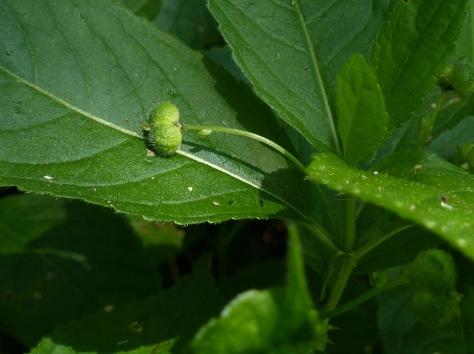 Dog’s Mercury is a green woodland plant that does best in partial shade. It appears very early in the year (January) and forms dense mats on the woodland floor.
Dog’s Mercury is a green woodland plant that does best in partial shade. It appears very early in the year (January) and forms dense mats on the woodland floor.
 A member of the Spurge family, (Euphorbiaceae) it spreads from it’s rhizomes (rootstalks) to form a large mass of plants that can shade others out.
A member of the Spurge family, (Euphorbiaceae) it spreads from it’s rhizomes (rootstalks) to form a large mass of plants that can shade others out.
Dog’s Mercury is dioecious, meaning that there are separate male and female plants.
The male plant carries spikes of flowers that open to reveal between eight and fifteen, pollen producing, stamens.
 The flower has no petals, it has three, lime green, tepals (a term used when sepals and petals are indistinguishable from each other)
The flower has no petals, it has three, lime green, tepals (a term used when sepals and petals are indistinguishable from each other)
 The female plant is much less conspicuous and most easily recognised by the lack of a flower spike.
The female plant is much less conspicuous and most easily recognised by the lack of a flower spike.
 Female flowers are carried singly on a long stem.
Female flowers are carried singly on a long stem.
 The female flower consists of a two lobed stigma above the ovary. The also have the three lime green tepals, soon hidden by the growing seeds.
The female flower consists of a two lobed stigma above the ovary. The also have the three lime green tepals, soon hidden by the growing seeds.
 The leaves of Dog’s Mercury are spear like (narrowly elliptic-ovate) and grow in opposite pairs. Most of the leaves are at the top of the stem.
The leaves of Dog’s Mercury are spear like (narrowly elliptic-ovate) and grow in opposite pairs. Most of the leaves are at the top of the stem.
 They are finely haired and have a toothed margin.
They are finely haired and have a toothed margin.
 The stem is unbranched and by this I mean that the leaves and flowers grow directly from the central stem.
The stem is unbranched and by this I mean that the leaves and flowers grow directly from the central stem.
 Similar species: The leaves and flowers of Annual Mercury (Mercurialis annua) look very similar to Dog’s Mercury, the big difference between the species is that Annual Mercury grows on branched stems, by this I mean that they grow on stems which branch off the main stem.
Similar species: The leaves and flowers of Annual Mercury (Mercurialis annua) look very similar to Dog’s Mercury, the big difference between the species is that Annual Mercury grows on branched stems, by this I mean that they grow on stems which branch off the main stem.
I don’t have pictures of Annual Mercury because in the UK, it only grows in the South East of England but if you are unsure of your identification then just Google for images of Annual Mercury and look at the stem.
Poison:
 (Dog’s Mercury growing amongst Wild Garlic)
(Dog’s Mercury growing amongst Wild Garlic)
Dog’s Mercury is extremely poisonous. The first recorded case of fatality comes from 1693 when a family of five ate it and one child subsequently died. They had boiled the plant before eating it. The most recent case of poisoning comes from the 1980’s and was reported in The British Medical Journal. A couple boiled and ate the plant, mistaking it for an edible. They were hospitalised for two days but recovered without any serious ill effects. Their recovery was put down to the fact that they had boiled the plant before eating it.
Serious cases of poisoning in Humans are rare because there is little reason why anyone would eat this plant, most cases must arise from mistaken identity, or just not noticing the leaves when you pick your Wild Garlic.
Poisoning is more common in animals with several cases of Sheep poisoning being reported. I have also read a lot of reports of Dogs being drawn to eat it and subsequent vomiting. The plant has an unpleasant smell that repels us but may attract Dogs.
Dog’s Mercury in January:
Kingdom: Plantae
Order: Malpighiales
Family: Euphorbiaceae
Genus: Mercurialis
Species: Mercurialis perennis









